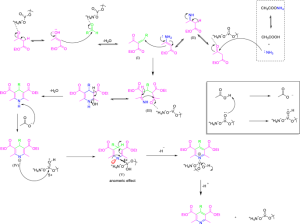Mechanism of Action of Ammonium Metavanadate

- Catalytic Reactions
In catalytic applications, ammonium metavanadate (NH4VO3) serves as a mild oxidizing agent. Its ability to facilitate the transfer of oxygen atoms is crucial in various chemical reactions, particularly in the synthesis of organic compounds. The vanadium in NH4VO3 can exist in multiple oxidation states, which allows it to participate in redox reactions. This redox versatility is harnessed in catalysis to promote the oxidation of substrates, leading to the formation of desired products.
For instance, NH4VO3 has been reported as an efficient catalyst for the synthesis of substituted pyridines and 1,4-dihydropyridines (1,4-DHPs) through a one-pot pseudo four-component reaction[1]. The study highlighted the role of NH4VO3 in the Hantzsch synthesis, where it facilitates the condensation and cyclization steps leading to the formation of pyridine derivatives. The catalytic action of NH4VO3 in this context is attributed to its ability to activate the carbonyl group of the aldehyde and the methylene group of the β-ketoester, which are key steps in the formation of the pyridine ring[1].
- Biological Systems
In biological systems, the mechanism of action of ammonium metavanadate is quite distinct from its role in catalysis. NH4VO3 can mimic the structure and function of phosphate groups due to the chemical and structural similarities between the vanadate ion (VO3-) and the phosphate ion (PO43-)[2, 3]. This mimicry allows NH4VO3 to interact with biological molecules that typically bind to phosphates, such as enzymes and proteins.
One of the key biological processes where NH4VO3 exerts its effect is the inhibition of protein tyrosine phosphatases (PTPs)[2, 3]. PTPs are enzymes that remove phosphate groups from tyrosine residues in proteins, which is a critical step in the regulation of signal transduction pathways. By mimicking phosphate, NH4VO3 can bind to the active site of PTPs, leading to their inhibition. This inhibition can alter signaling pathways, potentially leading to therapeutic effects.
For example, the inhibition of PTPs by vanadate compounds has been explored for its insulin-mimetic properties, which could be beneficial in the treatment of diabetes[4]. By inhibiting PTPs, NH4VO3 can enhance the phosphorylation of the insulin receptor and downstream signaling molecules, thereby improving insulin sensitivity and glucose uptake in cells[4].
Furthermore, NH4VO3 has been studied for its potential chemopreventive properties in cancer. It has been shown to reduce tumor incidence and size, possibly through the induction of apoptosis and reduction of cell proliferation[2]. The exact mechanisms by which NH4VO3 exerts these effects are complex and may involve the generation of reactive oxygen species (ROS), modulation of gene expression, and interference with cellular signaling pathways[2, 5].
In summary, the mechanism of action of ammonium metavanadate is multifaceted, with its role as a catalyst in chemical reactions being distinct from its biological activities. In catalysis, NH4VO3 acts as a mild oxidizing agent, while in biological systems, it mimics phosphate groups, leading to the inhibition of PTPs and potential therapeutic applications. The versatility of NH4VO3’s mechanisms underscores its significance in both industrial and medical fields.
- Rahimi, J., Niksefat, M., Heidari, M. et al. Ammonium metavanadate (NH4VO3): a highly efficient and eco-friendly catalyst for one-pot synthesis of pyridines and 1,4-dihydropyridines. Sci Rep 12, 13687 (2022). https://doi.org/10.1038/s41598-022-17378-7, Ammonium metavanadate (NH4VO3): a highly efficient and eco-friendly catalyst for one-pot synthesis of pyridines and 1,4-dihydropyridines.(2022).
- Irving, E., & Stoker, A. W. (2017). Vanadium Compounds as PTP Inhibitors. Molecules (Basel, Switzerland), 22(12), 2269. https://doi.org/10.3390/molecules22122269,Vanadium Compounds as PTP Inhibitors. .(2017).
- Dieter Rehder, T.r.o.v.i.b., Metallomics, Volume 7, Issue 5, May 2015, Pages 730–742, https://doi.org/10.1039/c4mt00304g, The role of vanadium in biology, Metallomics.May 2015,.
- Treviño, S., Díaz, A., Sánchez-Lara, E., Sanchez-Gaytan, B. L., Perez-Aguilar, J. M., & González-Vergara, E. (2019). Vanadium in Biological Action: Chemical, Pharmacological Aspects, and Metabolic Implications in Diabetes Mellitus. Biological trace element research, 188(1), 68–98. https://doi.org/10.1007/s12011-018-1540-6,Vanadium in Biological Action: Chemical, Pharmacological Aspects, and Metabolic Implications in Diabetes Mellitus. .(2019).
- Aureliano, M.D.S.-C., A.L.; Dolan, C.C.; Roess, D.A.; Crans, D.C. Biological Consequences of Vanadium Effects on Formation of Reactive Oxygen Species and Lipid Peroxidation. Int. J. Mol. Sci. 2023, 24, 5382. https://doi.org/10.3390/ijms24065382, Biological Consequences of Vanadium Effects on Formation of Reactive Oxygen Species and Lipid Peroxidation.2023.
